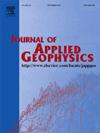扩散场假设下熊本ESG盲预测区地下结构识别
IF 2.2
3区 地球科学
Q2 GEOSCIENCES, MULTIDISCIPLINARY
引用次数: 0
摘要
本文通过SM、M和LL三种尺寸的传感器阵列收集的环境地震噪声数据,给出了熊本市具有代表性的速度剖面。利用SPAC和互相关等技术估计了瑞利波和洛夫波的相速和群速色散曲线。此外,对每个阵列分别进行水平-垂直光谱比(HVSR)分析,并对所得数据进行平均,生成一条具有代表性的HVSR曲线。通过在漫射场假设下的联合反演,同时拟合了频散曲线和HVSR数据,从而可以估计出一维速度剖面。该方法有效地解决了反演问题的非唯一性问题。此外,确定了上模态,并与已建立的模型进行了色散和HVSR曲线的比较分析,发现了需要彻底检查的显着差异。随后,以垂向分量为重点,进行地震能量分配分析。结果与色散图相关联,以确认模式识别的一致性。本文章由计算机程序翻译,如有差异,请以英文原文为准。
Subsurface structure identification at the blind prediction site of ESG in Kumamoto under the diffuse field assumption
A representative velocity profile for Kumamoto city is presented in this study, derived from ambient seismic noise data collected by three sizes sensor arrays SM, M, and LL. Phase and group velocity dispersion curves for both Rayleigh and Love waves were estimated using techniques such as SPAC and cross-correlations. Additionally, Horizontal-to-Vertical Spectral Ratio (HVSR) analysis was performed individually for each array, and the resulting data were averaged to generate a single representative HVSR curve. By employing joint inversion under the diffuse field assumption, dispersion curves and HVSR data were concurrently fitted, allowing for the estimation of a 1D velocity profile. This approach effectively addresses the non-uniqueness inherent in inversion problems. Furthermore, upper modes were identified, and a comparative analysis of dispersion and HVSR curves was conducted against those of an established model, revealing notable discrepancies requiring thorough examination. Subsequently, seismic energy partitioning analysis was carried out, focusing on the vertical component. The findings were correlated with dispersion diagrams to confirm consistency in mode identification.
求助全文
通过发布文献求助,成功后即可免费获取论文全文。
去求助
来源期刊

Journal of Applied Geophysics
地学-地球科学综合
CiteScore
3.60
自引率
10.00%
发文量
274
审稿时长
4 months
期刊介绍:
The Journal of Applied Geophysics with its key objective of responding to pertinent and timely needs, places particular emphasis on methodological developments and innovative applications of geophysical techniques for addressing environmental, engineering, and hydrological problems. Related topical research in exploration geophysics and in soil and rock physics is also covered by the Journal of Applied Geophysics.
 求助内容:
求助内容: 应助结果提醒方式:
应助结果提醒方式:


